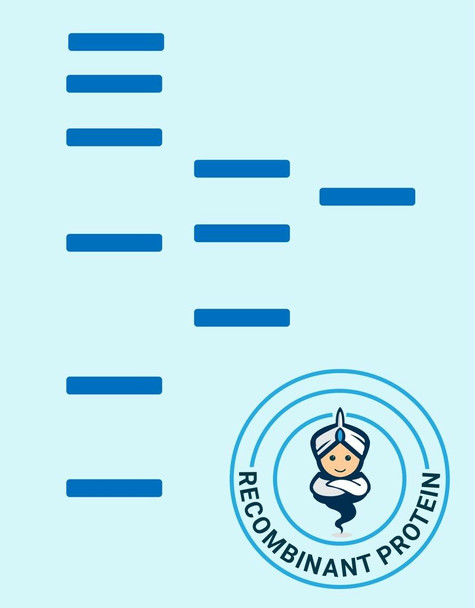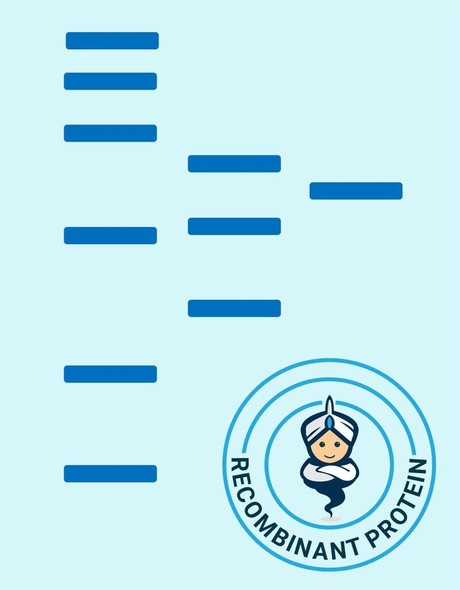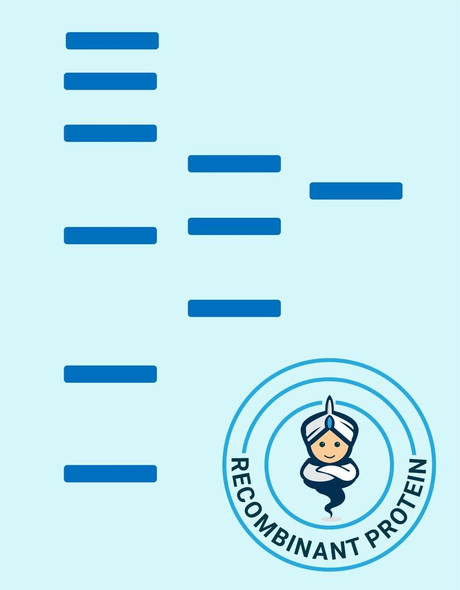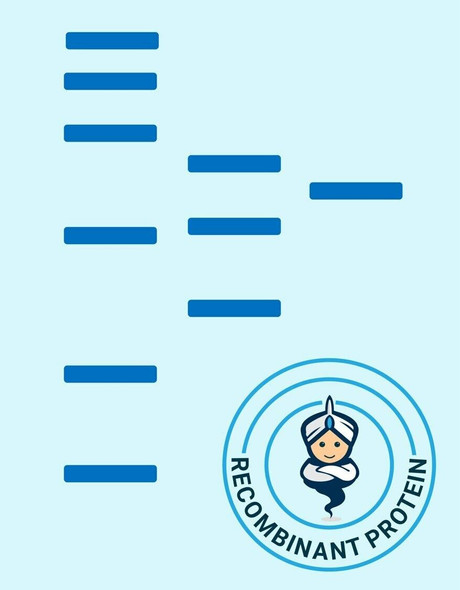Human OPG Fc Recombinant Protein (RPPB0816)
- SKU:
- RPPB0816
- Product type:
- Recombinant Protein
- Size:
- 50ug
- Species:
- Human
- Target:
- OPG Fc
- Synonyms:
- TNFRSF11B
- OPG
- OCIF
- Osteoclastogenesis inhibitory factor
- Source:
- Pichia Pastoris
- Uniprot:
- O00300
Description
| Product Name: | Human OPG Fc Recombinant Protein |
| Product Code: | RPPB0816 |
| Size: | 50µg |
| Species: | Human |
| Target: | OPG Fc |
| Synonyms: | TNFRSF11B, OPG, OCIF, Osteoclastogenesis inhibitory factor, TR1, MGC29565. |
| Source: | Pichia Pastoris |
| Physical Appearance: | Sterile Filtered White lyophilized (freeze-dried) powder. |
| Formulation: | OPG was lyophilized from a 0.2µm filtered concentrated solution in 20mM PB, pH 6.0, 150mM NaCl and 0.02 % Tween-80. |
| Solubility: | It is recommended to reconstitute the lyophilized Osteoprotegerin in sterile 18M?-cm H2O not less than 100µg/ml, which can then be further diluted to other aqueous solutions. |
| Stability: | Lyophilized Osteoprotegerin although stable at room temperature for 3 weeks, should be stored desiccated below -18°C. Upon reconstitution OCIF should be stored at 4°C between 2-7 days and for future use below -18°C. For long term storage it is recommended to add a carrier protein (0.1% HSA or BSA).Please prevent freeze-thaw cycles. |
| Purity: | Greater than 90.0% as determined by:(a) Analysis by RP-HPLC.(b) Analysis by SDS-PAGE. |
| Amino Acid Sequence: | OPG 22-201 ETFPPKYLHY DEETSHQLLC DKCPPGTYLK QHCTAKWKTV CAPCPDHYYT DSWHTSDECL YCSPVCKELQ YVKQECNRTH NRVCECKEGR YLEIEFCLKH RSCPPGFGVV QAGTPERNTV CKRCPDGFFS NETSSKAPCR KHTNCSVFGL LLTQKGNATH DNICSGNSES TQKCGIDVTL Fc232EPKSSDKTHT CPPCPAPEFE GAPSVFLFPP KPKDTLMISR TPEVTCVVVD VSHEDPEVKF NWYVDGVEVH NAKTKPREEQ YNSTYRVVSV LTVLHQDWLN GKEYKCKVSN KALPTPIEKTISKAKGQPRE PQVYTLPPSR DELTKNQVSL TCLVKGFYPS DIAVEWESNG QPENNYKTTP PVLDSDGSFF LYSKLTVDKS RWQQGNVFSC SVMHEALHNH YTQKSLSLSP GK |
| Biological Activity: | The ED50 as determined by neutralizing the stimulation of U937 cells is less than 10 ng/ml, corresponding to a specific activity of > 100,000IU/mg in the presence of 10ng/ml soluble human RANKL (sRANKL). |
Osteoprotegerin acts as decoy receptor for rankl and thereby neutralizes its function in osteoclastogenesis. OPG inhibits the activation of osteoclasts and promotes osteoclast apoptosis in vitro. Bone homeostasis seems to depend on the local rankl/opg ratio. Osteoprotegerin may also play a role in preventing arterial calcification. May act as decoy receptor for trail and protect against apoptosis. Trail binding blocks the inhibition of osteoclastogenesis.
Recombinant OPG produced in yeast contains 2x412 amino acid residues, including 180 residues from mature OPG (a.a 22-201) and 232 residues from the Fc protein of human IgG1, and has a calculated molecular mass of 109.6kDa.
| UniProt Protein Function: | TNFRSF11B: Acts as decoy receptor for RANKL and thereby neutralizes its function in osteoclastogenesis. Inhibits the activation of osteoclasts and promotes osteoclast apoptosis in vitro. Bone homeostasis seems to depend on the local RANKL/OPG ratio. May also play a role in preventing arterial calcification. May act as decoy receptor for TRAIL and protect against apoptosis. TRAIL binding blocks the inhibition of osteoclastogenesis. Defects in TNFRSF11B are the cause of juvenile Paget disease (JPD); also known as hyperostosis corticalis deformans juvenilis or hereditary hyperphosphatasia or chronic congenital idiopathic hyperphosphatasia. JPD is a rare autosomal recessive osteopathy that presents in infancy or early childhood. The disorder is characterized by rapidly remodeling woven bone, osteopenia, debilitating fractures, and deformities due to a markedly accelerated rate of bone remodeling throughout the skeleton. Approximately 40 cases of JPD have been reported worldwide. Unless it is treated with drugs that block osteoclast- mediated skeletal resorption, the disease can be fatal. |
| UniProt Protein Details: | Protein type:Secreted; Secreted, signal peptide; Inhibitor Chromosomal Location of Human Ortholog: 8q24 Cellular Component: proteinaceous extracellular matrix; extracellular space; extracellular region Molecular Function:cytokine activity; receptor activity Biological Process: response to drug; extracellular matrix organization and biogenesis; response to magnesium ion; negative regulation of odontogenesis of dentine-containing teeth; response to estrogen stimulus; apoptosis; response to arsenic; negative regulation of bone resorption; signal transduction; skeletal development; response to nutrient Disease: Paget Disease, Juvenile |
| NCBI Summary: | The protein encoded by this gene is a member of the TNF-receptor superfamily. This protein is an osteoblast-secreted decoy receptor that functions as a negative regulator of bone resorption. This protein specifically binds to its ligand, osteoprotegerin ligand, both of which are key extracellular regulators of osteoclast development. Studies of the mouse counterpart also suggest that this protein and its ligand play a role in lymph-node organogenesis and vascular calcification. Alternatively spliced transcript variants of this gene have been reported, but their full length nature has not been determined. [provided by RefSeq, Jul 2008] |
| UniProt Code: | O00300 |
| NCBI GenInfo Identifier: | 322510101 |
| NCBI Gene ID: | 4982 |
| NCBI Accession: | O00300.3 |
| UniProt Secondary Accession: | O00300,O60236, Q53FX6, Q9UHP4, B2R9A8, |
| UniProt Related Accession: | O00300 |
| Molecular Weight: | 46,026 Da |
| NCBI Full Name: | Tumor necrosis factor receptor superfamily member 11B |
| NCBI Synonym Full Names: | tumor necrosis factor receptor superfamily, member 11b |
| NCBI Official Symbol: | TNFRSF11B |
| NCBI Official Synonym Symbols: | OPG; TR1; OCIF |
| NCBI Protein Information: | tumor necrosis factor receptor superfamily member 11B; osteoprotegerin; osteoclastogenesis inhibitory factor |
| UniProt Protein Name: | Tumor necrosis factor receptor superfamily member 11B |
| UniProt Synonym Protein Names: | Osteoclastogenesis inhibitory factor; Osteoprotegerin |
| UniProt Gene Name: | TNFRSF11B |
| UniProt Entry Name: | TR11B_HUMAN |










